NMR Data Acquisition The process of data acquisition results in an ...
NMR Data Acquisition The process of data acquisition results in an ...
NMR Data Acquisition The process of data acquisition results in an ...
Create successful ePaper yourself
Turn your PDF publications into a flip-book with our unique Google optimized e-Paper software.
400 6. -14367<br />
Note that <strong>in</strong> 2D <strong>NMR</strong> the sampl<strong>in</strong>g <strong>in</strong> the second dimension c<strong>an</strong> also be done either way,<br />
except that this choice is up to the user <strong>an</strong>d is not “hard wired”. <strong>The</strong> alternate (“Bruker-like”)<br />
sampl<strong>in</strong>g method is called “TPPI” (for Time Proportional Phase Incrementation) <strong>an</strong>d the<br />
simult<strong>an</strong>eous (“Vari<strong>an</strong>-like”) method is called “States” or “States-Haberkorn” (after the orig<strong>in</strong>ators<br />
<strong>of</strong> the technique). <strong>The</strong> consequences for <strong>process</strong><strong>in</strong>g <strong>an</strong>d <strong>in</strong>terpretation <strong>of</strong> the <strong>data</strong> are the same <strong>in</strong><br />
the second dimension as they are <strong>in</strong> 1D <strong>NMR</strong>.<br />
This leads to confusion over two parameters: the number <strong>of</strong> po<strong>in</strong>ts collected (do you me<strong>an</strong> the<br />
total number <strong>of</strong> <strong>data</strong> po<strong>in</strong>ts, or the number <strong>of</strong> real / imag<strong>in</strong>ary pairs?) <strong>an</strong>d the time spac<strong>in</strong>g<br />
between <strong>data</strong> po<strong>in</strong>ts. Both Bruker <strong>an</strong>d Vari<strong>an</strong> list the number <strong>of</strong> <strong>data</strong> po<strong>in</strong>ts (Vari<strong>an</strong>: NP, Bruker:<br />
TD) as the total number <strong>of</strong> po<strong>in</strong>ts, count<strong>in</strong>g both real <strong>an</strong>d imag<strong>in</strong>ary. Some <strong>in</strong>dependent <strong>NMR</strong><br />
s<strong>of</strong>tware packages (e.g., Felix) count po<strong>in</strong>ts as “complex pairs”: one “po<strong>in</strong>t” corresponds to one<br />
pair <strong>of</strong> numbers (real <strong>an</strong>d imag<strong>in</strong>ary). <strong>The</strong> time spac<strong>in</strong>g between successive <strong>data</strong> po<strong>in</strong>ts sampled<br />
<strong>in</strong> the FID is called the dwell time (Bruker: DW). In the above example, the dwell time is clearly<br />
equal to 80 µs between samples for the Bruker <strong>data</strong>, but <strong>in</strong> the Vari<strong>an</strong> case we need to th<strong>in</strong>k <strong>of</strong><br />
the dwell time as the average time per sample, which is still 80 µs because two samples are<br />
collected <strong>in</strong> a period <strong>of</strong> 160 µs. Vari<strong>an</strong> does not have a parameter correspond<strong>in</strong>g to dwell time,<br />
leav<strong>in</strong>g the sampl<strong>in</strong>g <strong>process</strong> hidden from the user. <strong>The</strong> two types <strong>of</strong> <strong>data</strong> (alternate <strong>an</strong>d<br />
simult<strong>an</strong>eous) must be <strong>process</strong>ed by a different Fourier tr<strong>an</strong>sform method, but this is tr<strong>an</strong>sparent<br />
as long as you <strong>process</strong> the <strong>data</strong> on the <strong>in</strong>strument which acquired it. If you tr<strong>an</strong>sfer the <strong>data</strong> to a<br />
computer <strong>an</strong>d use “third party” s<strong>of</strong>tware (e.g., Felix) to <strong>process</strong> it, you need to choose the correct<br />
Fourier tr<strong>an</strong>sform method for the type <strong>of</strong> FID <strong>data</strong> be<strong>in</strong>g <strong>process</strong>ed.<br />
How rapidly do we need to sample the <strong>data</strong>? Clearly this is limited by how fast the<br />
hardware c<strong>an</strong> convert <strong>an</strong>alog to digital, but <strong>in</strong> most cases this limitation is not serious. It turns<br />
out that the rate <strong>of</strong> sampl<strong>in</strong>g is determ<strong>in</strong>ed by the highest frequency signal you need to describe<br />
by the digitized <strong>data</strong>. In other words, what peak <strong>in</strong> your spectrum is farthest from the center<br />
frequency (the reference frequency)? <strong>The</strong> highest frequency signal needs to be sampled at least<br />
twice dur<strong>in</strong>g each cycle <strong>of</strong> its s<strong>in</strong>e wave, me<strong>an</strong><strong>in</strong>g that the number <strong>of</strong> samples has to be twice the<br />
number <strong>of</strong> cycles <strong>in</strong> the highest frequency signal allowed.<br />
Number <strong>of</strong> Samples <strong>in</strong> 1 sec. = 1 / DW = 2 * Number <strong>of</strong> Cycles <strong>in</strong> 1 sec.<br />
1 / DW = 2 * F max<br />
Once we have chosen a particular dwell time DW, the maximum frequency we c<strong>an</strong> accurately<br />
determ<strong>in</strong>e (s<strong>in</strong>ce the computer doesn’t know <strong>an</strong>yth<strong>in</strong>g about the signal between the samples) is 1<br />
/ (2*DW). What happens if the frequency <strong>of</strong> a signal exceeds 1 / (2*DW)? <strong>The</strong> signal will not<br />
simply disappear; <strong>in</strong>stead it is mis<strong>in</strong>terpreted as a signal <strong>of</strong> lower frequency (Fig. 11). This<br />
<strong>process</strong> is called “alias<strong>in</strong>g” or “fold<strong>in</strong>g” because the peak appears at the wrong position <strong>in</strong> the<br />
<strong>NMR</strong> spectrum. Anyone who has watched Western movies or television shows has seen the<br />
phenomenon <strong>of</strong> alias<strong>in</strong>g. A film (or videotape) <strong>of</strong> a mov<strong>in</strong>g stagecoach will <strong>of</strong>ten show the<br />
wheels slow<strong>in</strong>g, com<strong>in</strong>g to a stop, or revers<strong>in</strong>g direction even though the stagecoach is still<br />
obviously mov<strong>in</strong>g forward at full speed. <strong>The</strong> film is sampl<strong>in</strong>g the position <strong>of</strong> the spokes at a rate<br />
27



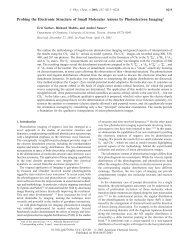
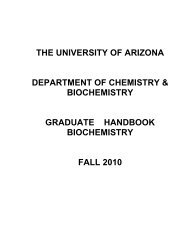
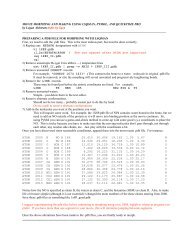
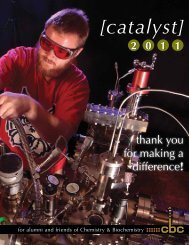

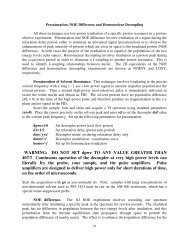


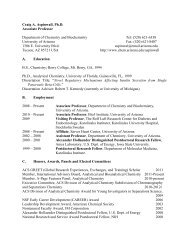
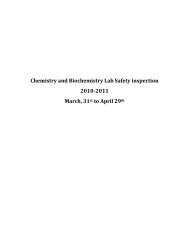
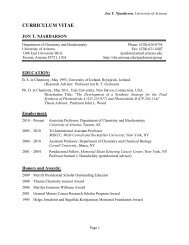
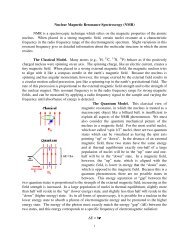
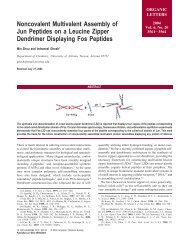
![Program [pdf] - Department of Biochemistry and Molecular ...](https://img.yumpu.com/8309921/1/167x260/program-pdf-department-of-biochemistry-and-molecular-.jpg?quality=85)